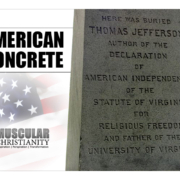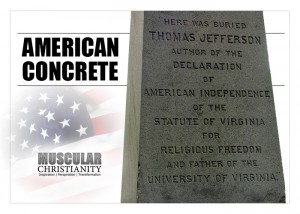American Concrete
When it comes to the topic of our nation’s Christian heritage, you have two main schools of thought:
- The liberal mindset that insists our forefathers viewed religion as something to be negotiated as an administrative duty
- The Conservative Christian platform that maintains an aggressive acknowledgement and pursuit of God’s Assistance characterized the collective perspective of the founding fathers
Much of the controversy stems from a ruling given by the Supreme Court in 1947 and the way they interpreted a phrase used by Thomas Jefferson in a letter he wrote to the Danbury Baptist Association in Connecticut in 1802. They declared that Jefferson’s usage of the term “the separation of church and state” constituted “the authoritative declaration of the scope and effect” of the First Amendment.1 Since then, that ruling has become the standard by which all public expressions of religious convictions have been measured, leading to an ever increasing limitation being put on the acknowledgement of God in governmental agencies as well as an ever lengthening shadow of doubt being cast on our nation’s religious heritage.
The debate is, at times, passionate and you’ve got buffoons on both sides of the aisle. The venom and the inaccuracies can culminate in a spectacle that can make it difficult to know which argument is correct. But there is a bottom line that transcends the way in which a solitary statement can be potentially dissected to the point where its meaning becomes illusive. That bottom line is to consider, not only the comment that was made, but also:
- the context of that comment
- the character of the person speaking
- the cultural backdrop that made what that person said both relevant and influential
In other words, rather than just scrutinizing what was said, look at also why it was said, to whom was the person speaking and who was it that made the comment. At that point, you’ve got a full color, three dimensional rendering of what was stated as opposed to an intentionally cropped, black and white snapshot.
Using that kind of approach, let’s take a look at Thomas Jefferson and his exchange with the Danbury Baptists.



